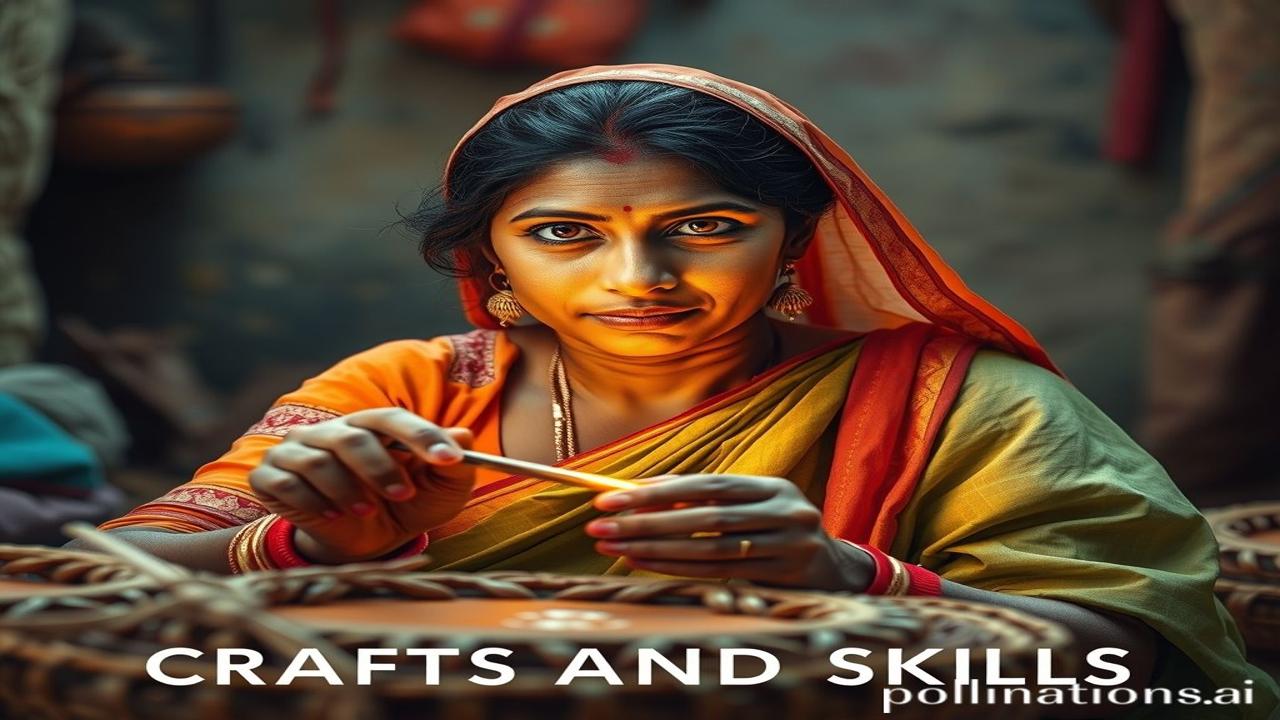Waqt Ki Dhool Mein Chhupi Hunar: Traditional Women’s Crafts and Skills
Kabhi socha hai, jab ghar ki chhat par dhoop sukh rahi ho, toh uss dhoop mein kitni kahaniyan chipi hoti hain? Stories of hands that spun thread, hands that embroidered dreams onto cloth, hands that built homes with mud and prayers. Yeh kahaniyan hain Bharat ki mahilaon ki, unke hunar ki, unki shakti ki, jo unhone generations se sambhalkar rakhi hai. Let’s dive into this vibrant tapestry of tradition!
Parampara Ki Deewaren: Ek Itihasik Nazar
Traditional women’s crafts and skills – yeh sirf kaam nahin the, yeh jeevan ka tareeka tha. Think back centuries, maybe even millennia! Yeh practices India ke har kone mein faili hui thi, from the Mughal era’s intricate embroidery to the ancient Indus Valley Civilization’s pottery.
What? We’re talking about everything from weaving and embroidery (like chikankari and kantha) to pottery, painting (think Madhubani), basket making, and even culinary arts. These weren’t just hobbies; they were integral to the household economy and cultural expression.
When & Where? This is a story etched across time and geography! Some practices, like cotton weaving, date back thousands of years. Others, like certain types of zardozi embroidery, flourished during the Mughal reign. From the villages of Rajasthan to the bustling cities of Bengal, women’s crafts were everywhere.
Why? Kyunki yeh hunar sirf zariya nahi the rozi roti ka, balki ek tareeka tha apni kahaniyan sunane ka, apni pehchaan banaye rakhne ka. They were a means of empowerment, creativity, and community building. Imagine a village where women gathered to dye yarn, sharing stories and laughter as they worked – that’s the power of these skills!
Ghar Angan Ka Sach: Jeevan Aur Kala
Imagine Maa Yashoda churning butter while humming a lullaby, her nimble fingers weaving magic on the spinning wheel later that evening. Or picture a Rajput princess embroidering a ghagra with intricate designs, each stitch a whispered promise of beauty and prosperity.
- The Artisan’s Life: Subah se lekar shaam tak, auratein apne hunar mein doobi rehti thi. Their days were filled with the rhythmic sounds of looms, the fragrant aroma of spices, and the vibrant hues of natural dyes.
- Tools of the Trade: Simple tools – wooden looms, hand-carved needles, clay pots – were transformed into instruments of artistry. These were not just objects; they were extensions of the artisan’s heart and soul.
- Dreams Woven in Thread: Each creation held a dream, a prayer, a wish. A phulkari shawl embroidered with flowers might symbolize fertility and happiness, while a meticulously crafted pot could represent abundance and prosperity.
“Beta, yeh rang aasmaan se churaya hai, aur yeh design meri maa ne sikhaya tha,” an imaginary grandmother might say, passing down the secrets of her craft to the next generation.
Aaj Ki Dharohar: Bharatiyata Ka Aaina
Even today, we see glimpses of these traditional crafts echoing in our lives. From the handloom sarees worn during festivals to the intricately painted diyas that light up Diwali, the legacy of these skills endures.
- Rituals and Celebrations: Many rituals still incorporate handmade items. Think of the haldi ceremony where turmeric paste, traditionally ground by women, is applied to the bride and groom.
- Art and Design: Modern designers are increasingly drawing inspiration from traditional motifs and techniques, giving these ancient skills a contemporary twist.
- Empowerment: Organizations are working to empower women artisans by providing them with a platform to showcase and sell their creations, helping them to sustain their livelihoods and preserve their cultural heritage.
Yeh Bharatiyata ka ek aisa rang hai, jo kabhi fika nahi padta. This connection to our past gives us a sense of identity and belonging, a feeling of being rooted in something timeless and beautiful.
Mazedaar Sach: Dhool Bhari Kitab Ke Panne
Log samajhte hain ki handicraft me paise nahi lekin sach yeh hai ki aaj kal many designers are paying really good cost. Also, many believe it’s just a rural thing, but urban women are increasingly taking up these crafts as a hobby and a way to connect with their roots.
Drishti Aur Bhavnayein: Indradhanush Ki Tarah
Imagine walking through a village market, the air thick with the scent of sandalwood and spices. The vibrant colors of the textiles catch your eye – crimson, saffron, emerald green. You can hear the gentle clatter of looms and the melodic voices of women singing traditional songs. You can feel the rough texture of handspun cotton and the smooth surface of a perfectly crafted pot. This is a sensory feast, a celebration of skill and creativity.
Antim Vichar: Chhayee Hui Yaadein
Sanskriti humari dharohar hai, aur yeh hunar uski roshni. Let’s keep the flame burning.
“हस्तस्य भूषणं दानं, सत्यं कण्ठस्य भूषणम् |
श्रोत्रस्य भूषणं शास्त्रं, भूषणै: किम् प्रयोजनम् ||”
(The ornament of the hand is charity, the ornament of the throat is truth, the ornament of the ear is scripture, what is the need of other ornaments?)
This shloka reminds us that true adornment lies not in material possessions, but in our actions, our words, and our knowledge. And perhaps, in the skills we inherit and pass on to future generations. Let’s cherish and celebrate the artistry that flows through our veins, connecting us to the rich tapestry of our past.
